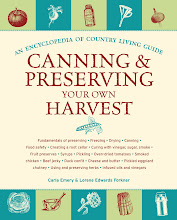We all know we should eat organic. But sometimes, organic isn’t readily available or a meager budget gets the best of us. Thankfully, Carla Emery has a few easy tricks to minimize our pesticide and chemical intake and help keep us healthier.
1. When eating meat or fish, discard the fat.
2. Don’t eat organ meats: liver, brains, sweetbreads, kidneys, heart, or gizzard. The poisons tend to concentrate in organs.
3. Avoid smoked foods and cured meats such as bacon and ham. They contain potentially carcinogenic nitrates and nitrites as well as the usual run of contaminants.
4. Meat from young animals is less likely to be contaminated than meat from older ones. Contamination is a lifelong accumulation.
5. About food from water: Choose fish over shellfish, ocean fish over river or lake fish, deep-ocean fish over shore- or bottom-feeding fish. In the case of meat-eating predator fish, choose small fish over large fish (the more they eat, the more they grow and the more foodchain poisons have accumulated in their bodies). Fishfarm fish are normally raised in water that doesn’t contain PCBs, mercury, or other chemicals, so they’re the best of all from that point of view; however, they are typically fed small doses of antibiotics every day.
6. When eating dairy products, eat products that are skim or as nearly skim as possible. The best dairy foods are skim milk, nonfat yogurt, and nonfat cottage cheese.
7. But use butter rather than margarine! You need some fat in your diet to be healthy — for your brain to do its best. Margarine is much worse for you than butter!
8. Choose fruits and vegetables that can be peeled. Wash them with unscented dish soap and rinse well. Then peel before eating. Forget everything you’ve heard about vitamins from eating peelings. A baked potato with peel has an average 30 percent more pesticide residue than a peeled, boiled one. It’s even worse with waxed fruits and vegetables. The wax that is applied to them typically contains fungicides (another poison). In addition, the wax layer seals in the previous layers of pesticides; if waxed, you can’t wash anything off. But you can still peel some residues away.
9. Peeling doesn’t guarantee that there are no residues. Cooked foods are always safer from the residue point of view, although cooking destroys vitamins. The “systemic” kinds of poisons get into the flesh of the fruit or vegetable rather than just lodging on the peel. Cooking detoxifies some — but not all — of them.
10. Concentrated fruit products have concentrated residues. Raisins, prunes, jams, jellies, fruit juices, and wine are all more likely to have residues than single fruits, because they’re made of concentrations of fruit.
11. Sweeteners are low-residue foods. This really turns the long-standing wisdom on its ear. For some reason or other, honey, corn syrup, maple syrup, and molasses — and yes, white sugar too — are all exceptionally low-residue foods and therefore are good from this point of view! Chocolate, however, is sometimes contaminated.








No comments:
Post a Comment